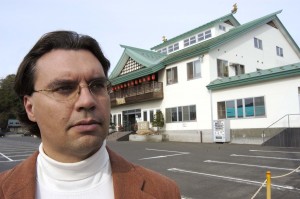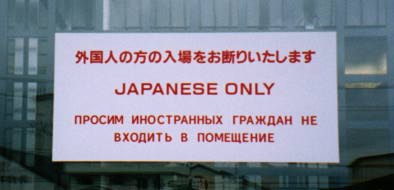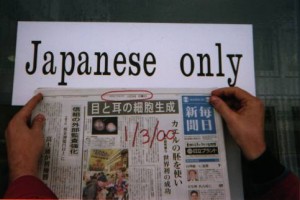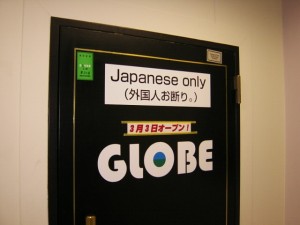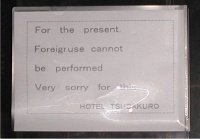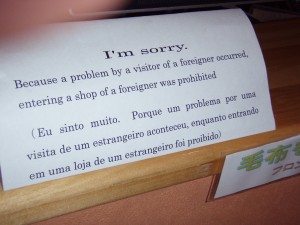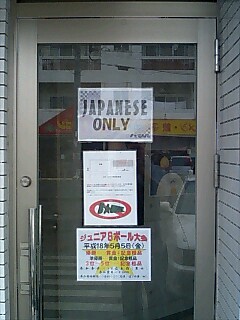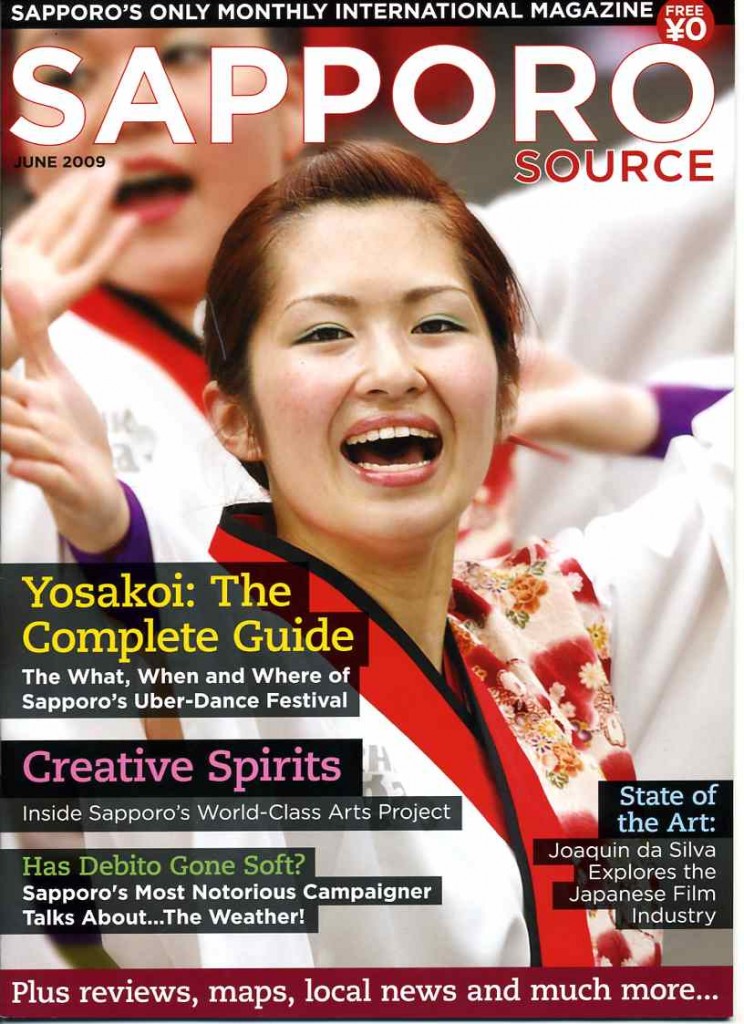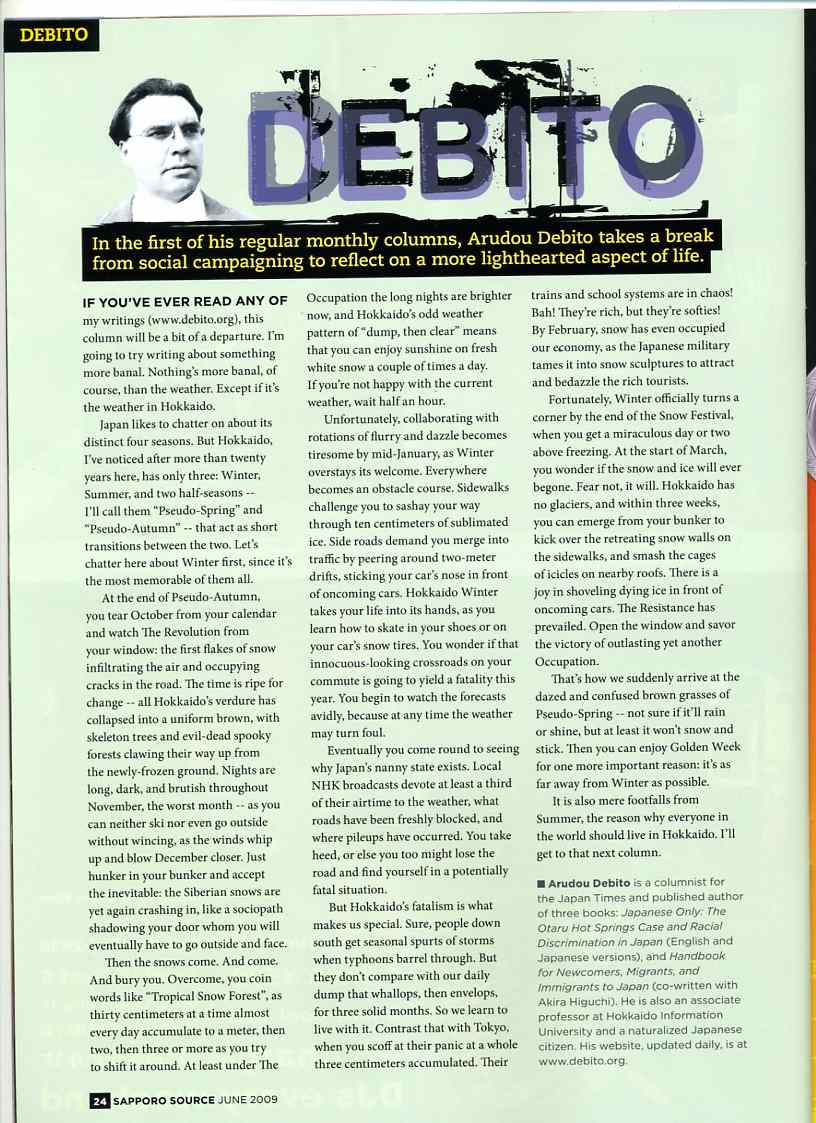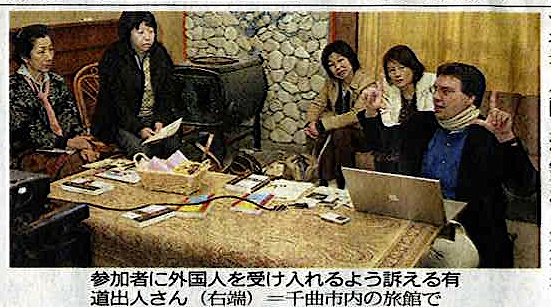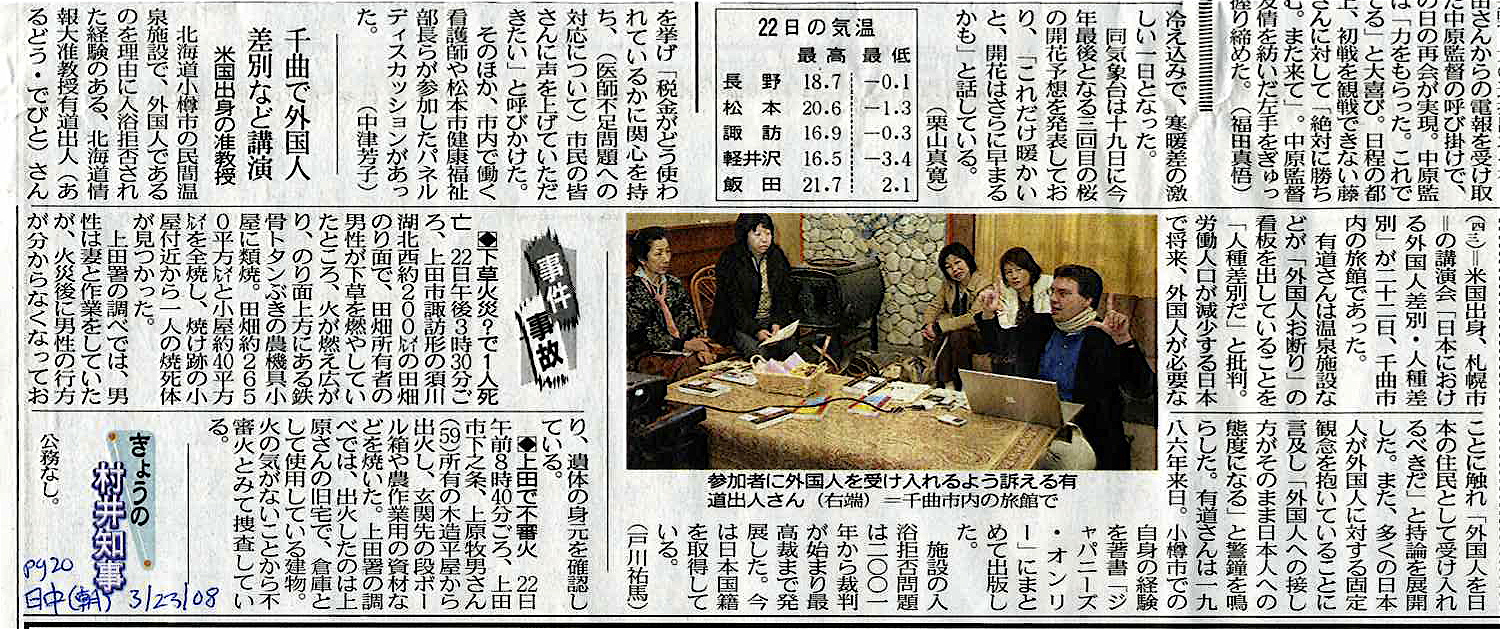mytest
DEBITO.ORG NEWSLETTER OCTOBER 3, 2006
/////////////////////////////////////////////////
1) J TIMES: DEVELOPMENTS IN FOREIGNER TRACKING AND QUALIFICATION
2) SPORT: BASEBALL “ANTI-GAIJIN” COMMENTS RE FOREIGN COACHES
3) J TIMES: ENFORCED “KIMIGAYO” PATRIOTISM RULED UNCONSTITUTIONAL
4) ROGUES’ GALLERY: “JAPANESE ONLY” SIGN IN OHTA-SHI, GUNMA PREF.
5) ADDITIONS TO UNIV BLACKLIST: RITSUMEIKAN, KYOTO SANGYO, KITAKYUSHU
6) ADDITIONS TO UNIV GREENLIST: UNIVERSITY OF AIZU
7) J TIMES ON LINGUAPAX ASIA CONFERENCE THIS WEEKEND AT TOKYO UNIV
(I’M SPEAKING THERE TOO:
LINKS TO MY PAPER AND POWERPOINT PRESENTATION BELOW)
/////////////////////////////////////////////////
Back issues, archives, and real-time updates at
https://www.debito.org/index.php
This post is freely forwardable.
/////////////////////////////////////////////////
1) J TIMES: DEVELOPMENTS IN FOREIGNER TRACKING AND QUALIFICATION
These are some important developments in the future of immigration to Japan. Some proposals are quite sensible, if done properly. Article excerpts with comments follow:
“Foreigners to need ‘skills’ to live in Japan
Justice panel takes aim at illegal aliens”
http://search.japantimes.co.jp/mail/nn20060923a1.html
Japan Times, Sept 23, 2006
————-ARTICLE EXCERPT BEGINS———————
A Justice Ministry panel discussing long-term policies for accepting overseas workers said Friday the government should seek out those with special skills and expertise to cope with the shrinking labor force in Japan….
The proposal by the panel headed by Kono also claimed that reducing the number of illegal foreign residents will help the country regain its reputation as “the safest country in the world,” ultimately creating an environment where legal foreign workers can become a part of society. As suggested in the panel’s interim report released in May, the panel said foreigners who want to work in Japan, including those of Japanese descent, must have a certain degree of proficiency in the Japanese language to be granted legal status.
————-ARTICLE EXCERPT ENDS———————–
COMMENTS: I am largely in favor of these proposals, as long as the government (as I said in previous writings) keeps the language evaluation independently certifiable–not letting it become another means for labor force abuse (by allowing bosses to wantonly decide whether or not workers are “jouzu” enough).
Also glad to see they dropped the hitherto proposed “3% foreigner population cap” as unworkable. Inevitably they would end up kicking foreigners out as the Japanese population dropped. See the original proposal and a critique at
https://www.debito.org/japantimes071106.html
Also, got this comment from a friend:
—————————————————————
Did you see the results of the public comment drive for the Kono report? According to the report (available on the Justice Ministry website at http://www.moj.go.jp/NYUKAN/nyukan51-2-1.pdf), they got 437 responses (well, that they officially validated, but that’s another plate of sushi).
Of these, 426, or 98 percent, were opposed to expanding the number of foreign workers. Even those few who wanted to expand the the number of foreign workers apparently said that solving the problem of “public safety” was a condition for their agreeing. Proof, as if we need more, that the foreigners-as-dangerous-criminals-propaganda over the past five years or so has been chillingly effective.
I’d be curious to learn how many people you know or know of wrote in. If it was more than a dozen, I think a fair question to Mr. Kono would be whether the opinions of resident foreigners were included in the survey.
—————————————————————
Did anyone else respond to the MOJ request for info?
Please let me know at debito@debito.org.
Now for the next article concerning immigration:
“Govt to check foreign staff situation
Plans to have firms report worker details”
The Yomiuri Shimbun, Sept 23, 2006
http://www.yomiuri.co.jp/dy/national/20060923TDY01004.htm
————-ARTICLE EXCERPT BEGINS———————
By making it obligatory for companies to report foreign workers’ details, the government hopes to keep track of people on an individual basis, and to enhance measures for clamping down on those working illegally. In addition, it is hoped the measures will encourage foreign workers to take out social insurance, and allow central and local governments to offer better support to workers who have to change jobs frequently due to unstable contracts.
The government’s three-year deregulation program, finalized in March, discusses making it mandatory for firms to submit reports on their foreign employees and whether reports should include detailed information such as workers’ names and residence status. The policy is likely to prove controversial in light of the protection of foreign workers’ privacy and the impact of the new system on the economy.
————-ARTICLE EXCERPT ENDS———————–
COMMENT: Quite honestly, I am of two minds on this proposal. Depends on who the true target of this policy is: The employer (to force them to employ legal workers, and force them to take responsibility when they don’t? It would be about time.), or the foreign employee? (in another attempt to “track” them constantly, an extension of the proposed “Gaijin Chip” IC Card system? See my Japan Times article on this at
https://www.debito.org/japantimes112205.html )
It’s a wait-and-see thing for me, as there is no way to determine how it will be enforced until it is enforced. Witness the April 2005 revisions of hotel laws, requiring passport checks of tourists, which gave the NPA license to order hotels nationwide to demand passport checks of ALL foreigners (regardless of residency):
https://www.debito.org/japantimes101805.html.
/////////////////////////////////////////////////
2) SPORT: BASEBALL “ANTI-GAIJIN” COMMENTS RE FOREIGN COACHES
Story about frustrated player making anti-gaijin remarks about his coach, our own Hokkaido Nippon Ham Fighters Trey Hillman, who has had a simply incredible season (and may take the pennant for the first time for this new team). Excerpt follows:
————-ARTICLE EXCERPT BEGINS———————
At this stage of the season, the only thing any player should be thinking about is winning the pennant…
However, that was vastly overshadowed by the actions of Fighters starter Satoru Kanemura, who threw a major hissy fit due to being pulled by manager Trey Hillman in the fifth inning needing just one out to become the first Nippon Ham hurler to rack up five straight ten win seasons since Yukihiro Nishimura.
After the game, he told the press that. yanking him was “absolutely unforgivable” and then took a racial shot at Hillman, grumbling that, “because he’s a foreigner, he doesn’t care about players’ individual goals.” He then challeneged reporters to print his remarks. “I don’t even want to look at him,” Kanemura said of Hillman.
[Original Japanese: “Zettai ni yurusanai. Gaikokujin wa kojin kiroku wa dou de mo ii n deshou. Shinユyou ga nai tte iu koto. Kao mo mitakunai.”) (Doshin Sept 25)
http://www.hokkaido-np.co.jp/Php/kiji.php3?&d=20060925&j=0034&k=200609254200 ]
In addition, he accused the former Rangers farm director of being more indulgent with Iranian-Japanese righthander Yu Darvish than him. In the context of this little explosion, that also has a racial tinge to it. Kanemura also beefed that he didn’t think Hillman trusted him….
Kanemura… was immediately taken off the roster for the duration of the playoffs and told to not even show up at practice Monday…
————-ARTICLE EXCERPT ENDS———————–
Entire article at
http://www.japanbaseballdaily.com/pacificleague9-24-2006.html
Funny to hear a Japanese accuse a foreigner holding the group in higher regard than the individual…
Where this went next:
————-ARTICLE EXCERPT BEGINS———————
Kanemura suspended, fined Y2 million for criticizing Hillman
Japan Today, Tuesday, September 26, 2006
http://www.japantoday.com/jp/news/385253
TOKYO Nippon Ham Fighters right-hander Satoru Kanemura received a suspension until the end of the playoffs and a 2 million yen fine Monday for criticizing the decision of team manager Trey Hillman, officials of the Pacific League club said. Nippon Ham removed Kanemura from the active roster the same day, following the 30-year-old’s comments from the previous day…. (Kyodo News)
————-ARTICLE EXCERPT ENDS———————–
COMMENT: While I support the sanctions meted out (for “criticizing the manager’s decision”, not for a “gaijin coach slur”, note), why am I not surprised by this development? Is it a given or a natural law that sooner or later, somebody’s foreignness is inevitably made an issue of here? I know Japan isn’t alone in this regard by any means, but one can hope that things can improve. Especially given the degree of fan service and overall relaxedness that the Fighters under Hillman have displayed–and still look likely to win the pennant! Nice guys can finish first. It’s just a shame that in the heat of the moment, the race card (or gaijin card, whichever interpretation you prefer) has to surface.
Bravo to showing zero tolerance for this sort of thing. Kanemura apologized on his blog (not for the “foreign coach” thingie, however–see http://satoru-kanemura.cocolog-nifty.com), and the apology was accepted by Hillman.
But let’s go deeper. There are plenty of books and articles out there talking about how foreign players, umpires, even coaches are treated in Japan without the due respect they deserve, suffering great indignities due to their “gaijin” status.
And it wasn’t just Hillman last week. During the September 25 high school draft picks for professional teams, one of the stars, Ohmine Yuuta, got his hopes up to be picked by Softbank Hawks. It was supposed to be a done deal, but Bobby Valentine, coach of Chiba Lotte, put in a bid as well for him. As is the established precedent, both Softbank and Lotte drew from a lottery, and Lotte by chance won. Suddenly. Ohmine declined to join Lotte, which is quite a scandal in itself.
But you just gotta pick on the gaijin. The HS coach of Ohmine’s team, a Mr Ishimine Yoshimori, refused to even meet with Valentine on September 26, citing the following reason:
“Americans won’t comprehend our words or feelings.”
(amerikajin to wa, kotoba mo kimochi mo tsuujinai)
Thus Coach Ishimine publicly rebuked Valentine due to some kinda foreign “language barrier”. What an example to set in front of his students! Courtesy Sports Houchi September 27, 2006:
http://hochi.yomiuri.co.jp/baseball/npb/news/20060927-OHT1T00081.htm
Amazing. Major coaches with worldwide reputations, like Valentine, are thus in the end still just gaijin, shown rudeness unthinkable between Japanese in this context. Remember who Valentine is: He brought Lotte to its first pennant win last year in a generation–31 years–the first foreign coach ever to do so.
http://www.japantoday.com/jp/news/353246
It looks like Trey Hillman may be the second, two years running.
Final word: Shortly after I posted about Hillman, a friend brought up the argument that he didn’t see anything particularly racist or xenophobic about Kanemura’s comments. I answer that on my blog at
https://www.debito.org/?p=42
If the World Cup 2006 can explicitly make “no racism” an official slogan, isn’t it time for Japan’s sports leagues to stop sweeping this issue under the carpet, and make an official statement banning it as well?
/////////////////////////////////////////////////
3) J TIMES: ENFORCED “KIMIGAYO” PATRIOTISM RULED UNCONSTITUTIONAL
This matters to this newsletter because enforced patriotism (particularly in the ways emerging under the creep towards the right wing in Japan) is anathema to multiculturalization and multiethnicity. What are the children of immigrants to say when asked how much they love their country, and be graded on it? (As is happening in grade schools in Saitama and Kyushu.) The “Kimigayo” Issue, where here people are exposed to punishment and job dismissal if they don’t stand and sing the national anthem, is a bellwether. Fortunately, some people are willing to stand up for themselves. Consider some Tokyo educators:
“City Hall to appeal ‘Kimigayo’ ruling”
Japan Times, Sept 23, 2006
Courtesy http://search.japantimes.co.jp/cgi-bin/nn20060923a2.html
————-ARTICLE EXCERPT BEGINS———————
In Thursday’s ruling, presiding Judge Koichi Namba said the Tokyo school board cannot force teachers to sing “Kimigayo” before the flag or punish them for refusing to do so, because that infringes upon the freedom of thought guaranteed by the Constitution…
Tokyo Gov. Shintaro Ishihara said Friday that City Hall will appeal Thursday’s 12.03 million yen district court ruling against the “Kimigayo” directive, which obliges Tokyo’s teachers to sing the national anthem before the national flag at school ceremonies.
He also said punishing teachers for not obeying the directive from the Tokyo Metropolitan Government board of education was “only natural because they neglected their duties as teachers.”
————-ARTICLE EXCERPT ENDS———————–
COMMENT: Quite a blow — Tokyo District Court, usually quite conservative, actually ruled against the government. Bravo. No word, however, on whether this ruling actually reinstates the suspended teachers or reverses their punishments (I suspect not).
More on this issue in the LA Times at
http://www.latimes.com/news/nationworld/world/la-fg-flag22sep22,1,314185.story?ctrack=1&cset=true
/////////////////////////////////////////////////
4) ROGUES’ GALLERY: “JAPANESE ONLY” SIGN IN OHTA-SHI, GUNMA PREF.
The Rogues’ Gallery of Exclusionary Businesses, excluding customers by race and nationality (or a salad of the two), has just had an update. Joining the 19 cities and towns with a history of exclusionary signs is:
“Pub Aliw”, Iida-Chou, Ohta City, three blocks from JR Ohta:
https://www.debito.org/roguesgallery.html#Ohta
This in a town full of Japanese-Brazilians, and a Filipina pub to boot (looking for foreign arubaito, according to a notice on the lower part of the door–in English!). No foreigners allowed–unless they work here!
Nice lettering on the exclusionary sign, though. Nothing like being told “Get lost Gaijin!” in a nice font.
But all is not bad news replete with irony. Also added a photo of a yakiniku restaurant in egregious excluder Monbetsu City last summer (“Mitsuen”–Monbetsu Ph 01582-4-3656). You can see a picture of me tip-top condition (having cycled 800 kms to get there) getting a “JAPANESE ONLY” sign down from there. You can also see a cat posing with me, as she had just been fed by the owners. Cats welcome, foreigners not.
https://www.debito.org/roguesgallery.html#monbetsuaug06
Luckily, when we asked owners to take the sign down, they quickly complied! Pity it only took six years and a personal coaxing from us.
Also, and I might have mentioned this before, but what the heck: It’s irony that works in our direction…
An exclusionary sign also technically came down in egregious excluder Wakkanai City as well. Actually, public bath Yuransen (which not only illegally refused foreign taxpayers entry–it opened a segregated “gaijin bath” with a separate entrance, and charged foreigners more than six times the Japanese price to enter!) technically took its sign down because it went out of business. Photo at
https://www.debito.org/roguesgallery.html#wakkanaiaug06
So much for the claim by the management that letting foreigners in would drive them bankrupt…
/////////////////////////////////////////////////
5) ADDITIONS TO UNIV BLACKLIST: RITSUMEIKAN, KYOTO SANGYO, KITAKYUSHU
The Blacklist of Japanese Universities, a list of institutions of higher learning which refuse to provide permanent tenure to their foreign full-time faculty, has been revised again for the time being. It is a good indicator of how language instruction in Japan is being even further ghettoized in Japan’s tertiary education.
Joining the crowd of 98 Blacklisted universities is world-famous RITSUMEIKAN UNIVERSITY, which is upping its own ante to show the world how rotten they can make things for their foreigners. According to their most recent job advertisement, they are disenfranchising their foreign faculty further (with “shokutaku” positions), adding more languages to the roster of disenfranchised positions, and even cutting their salary (compared to a job ad of few years ago) by nearly a third!
https://www.debito.org/blacklist.html#ritsumeikan
KYOTO SANGYO UNIVERSITY is doing much the same thing, with contract positions containing a heavy workload and unclear extra duties:
https://www.debito.org/blacklist.html#kyotosangyo
Finally, long-Blacklisted KITAKYUSHU UNIVERSITY has arguably improved things, revising its job description to offer longer contract terms, with the possibility (they say) of permanent tenure for foreign faculty.
https://www.debito.org/blacklist.html#kitakyushu
We’ll just have to wait and see, as the programs were inaugurated in April 2006. Fortunately, according to foreign faculty at the school, KU does currently have tenured foreigners, which means that it has also been moved to the Greenlist.
https://www.debito.org/greenlist.html#kitakyushu
If you want an example of how things could be done more equitably in Japan’s university system, go to the GREENLIST OF JAPANESE UNIVERSITIES at
https://www.debito.org/greenlist.html
A good example of a nice job offer can be seen in the job advertisement for AIZU UNIVERSITY, which joins 31 other Greenlisted schools.
https://www.debito.org/greenlist.html#aizu
Bravo. Submissions to either list welcome at debito@debito.org.
Submission guidelines available on the lists.
(It may take some time for me to get to listing things, sorry. Volunteer work is like that.)
/////////////////////////////////////////////////
6) J TIMES ON LINGUAPAX ASIA CONFERENCE THIS WEEKEND AT TOKYO UNIV (I’M SPEAKING TOO)
Got some spare time on Saturday, October 7? Come to the Tokyo University Komaba Campus and see me and others speak on language issues. The Japan Times even covered it last weekend:
————-ARTICLE EXCERPT BEGINS———————
Personality Profile–Frances Fister-Stoga and Linguapax Asia
Japan Times Saturday, Sept. 30, 2006
http://search.japantimes.co.jp/cgi-bin/fl20060930vk.html
The Linguapax Institute, located in Barcelona, Spain, is a nongovernmental organization affiliated with UNESCO. Linguapax Asia, associate of the Linguapax Institute, carries out the objectives of the institute and of UNESCO’s Linguapax Project, with a special focus on Asia and the Pacific Rim. The objectives cover issues ranging over multilingual education and international understanding, linguistic diversity, heritage and endangered languages, and links between language, identity, human rights and peace. Frances Fister-Stoga, lecturer at Tokyo University, is director of Linguapax Asia…
This is the third annual international symposium organized by Linguapax Asia. It is open to the general public as well as to those with professional interest. Registration is not in advance, but at 8:30 a.m. on the day, Oct. 7, in building 18 of the Komaba campus of Tokyo University. The fee is 1,000 yen. The session will begin at 9 a.m.
Keynote speaker in the morning session will be Charles De Wolf, professor at Keio University, translator, writer and expert on East Asian and Oceanic languages. He will discuss multilingualism and multiculturalism. The afternoon keynote speaker will be Arudo Debito, a professor at Hokkaido Information University and author on human rights issues. He will discuss the question of language and nationality. A dozen other distinguished speakers and two workshops will round out the day.
Web site: http://www.Linguapax-Asia.org
————-ARTICLE EXCERPT ENDS———————–
For those who are unable to make it, you can download my paper (still in draft form) in Word format at
https://www.debito.org/arudoulinguapax2006.doc
Download my accompanying Powerpoint Presentation at
https://www.debito.org/arudoulinguapax2006.ppt
My paper’s abstract:
============ABSTRACT BEGINS=============================
In Japan, a society where considerations of “nationality” and “language possession” seem to be closely intertwined, the author finds from his personal experience that having Japanese citizenship is an asset to communicating in Japanese to native Japanese. More indicative is the author’s survey of over two hundred Japanese college students on “What is a Japanese?” over the course of ten years. His findings are that people who have Japanese language ability are more likely to be viewed as “Japanese” than if they do not–even if the fluent do not have citizenship. The author feels this non-racially-based construct for determining inclusion in a society is a very hopeful sign for Japan’s future as a multicultural, multiethnic society.
===========ABSTRACT ENDS================================
I think that’s about enough for today. Thanks as always for reading! I will be slower to respond while I’m on the road for the next three weeks…
Arudou Debito
Sapporo, Japan
debito@debito.org
https://www.debito.org
DEBITO.ORG NEWSLETTER OCT 3 2006 ENDS






![]()



